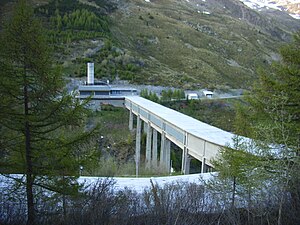Great St. Bernhard Tunnel
| Great St. Bernhard Tunnel | ||
|---|---|---|
|
Tunnel exit on the Italian side
|
||
| use | Motorway tunnel | |
| traffic connection | Switzerland: A21 / H21 | |
| length | 5798 m | |
| vehicles per day | 1700 (as of 2012) | |
| Number of tubes | 1 | |
| construction | ||
| Client | SISEX SA | |
| start of building | 1958 | |
| completion | 1964 | |
| business | ||
| release | March 19, 1964 | |
| location | ||
|
|
||
| Coordinates | ||
| North portal at Bourg-Saint-Pierre | 580966 / 83050 | |
| State border in the tunnel | 579341 / 79243 | |
| South portal at Saint-Rhémy-en-Bosses | 45 ° 51 '5 " N , 7 ° 9' 42" E | |
The Grosser-St.-Bernhard-Tunnel ( French tunnel du Grand-Saint-Bernard , Italian traforo del Gran San Bernardo ) is a 5798 m long road tunnel that connects Martigny in the Swiss canton of Valais and the Italian Aosta the Great St. Bernhard Pass at an altitude of around 1900 m above sea level. M. crosses.
history
The tunnel was built from the spring of 1958, the tunnel boring machine was driven from both sides. On March 19, 1964, it was put into operation as the first road tunnel to cross the Alps. Control posts and buildings for this are located at both ends of the tunnel.
properties
The state border is at tunnel meter 2938, measured from the Swiss north portal. The tunnel is slightly sloping, from the north portal ( 1918 m above sea level ) at Bourg-Saint-Pierre to the south portal ( 1875 m above sea level ) at Saint-Rhémy-en-Bosses on the Italian side.
The tunnel consists of a carriageway with oncoming traffic. The maximum speed is 80 km / h. Since it is a private tunnel, the passage through the Grossen-St.-Bernhard-Tunnel is chargeable, regardless of whether a Swiss motorway vignette has been purchased or not. The Oléoduc du Rhône oil pipeline from the port of Genoa to the Collombey refinery , which was closed in 2015, is located in the substructure of the tunnel .
1,200 vehicles crossed the tunnel on the opening day, compared to 620,000 in 2013.
The operator of the tunnel is SISEX SA ( Société Italo-Suisse d'exploitation du Tunnel du Grand-Saint-Bernard ) based in Bourg-Saint-Pierre . It is owned equally by the Swiss company Tunnel du Grand-Saint-Bernard (TGSB) and the Italian company Traforo del Gran San Bernardo (SITRASB). The main shareholders of TGSB are the cantons of Vaud, Valais and the city of Lausanne; SITRASB belongs to 63.5% of the Autonomous Region of Aosta , the rest of the SAV ( Society of Aosta Valley Motorways ).
In 2006, because of the two-state operator, Italy, Switzerland and the EEC agreed to collect tolls "without VAT or any other sales tax".
Maintenance work is carried out regularly in autumn and the tunnel is closed for nights or days. The tunnel can then be bypassed via the Grossen-St.-Bernhard-Pass ( 2469 m above sea level ) or the Simplon Pass .
Service and rescue tunnel
In 2010, the construction of the service and rescue tunnel began at a distance of 22 m from the center of the tunnel. A total of 23 cross connections are made every 240 m. The tunnel was pierced in 2012. The opening originally planned for 2015/2016 was delayed by one year due to differences between the operating company and the construction company.
literature
- Bernard Janin: Les tunnels routiers du Mont-Blanc et du Grand-Saint-Bernard, les perspectives de leur ouverture pour la vallée d'Aoste. In: Revue de Géographie Alpine, 1962, pp. 87–120.
Web links
- Great St. Bernhard Tunnel on the ETHorama platform
- Website of the tunnel operator SISEX SA
Individual evidence
- ↑ Moneyhouse: Société italo-suisse d'exploitation du Tunnel du Grand-Saint-Bernard SA entry in the commercial register, moneyhouse.ch, February 17, 1964, accessed September 22, 2017.
- ↑ entry SISEX SA letunnel.com, accessed September 22, 2017.
- ↑ entry service and rescue tunnel letunnel.com accessed September 22, 2017.


